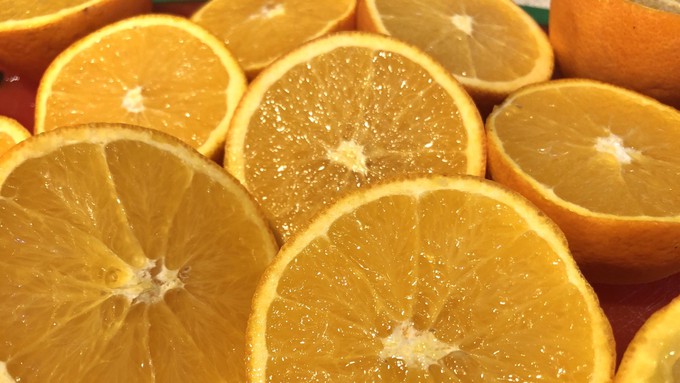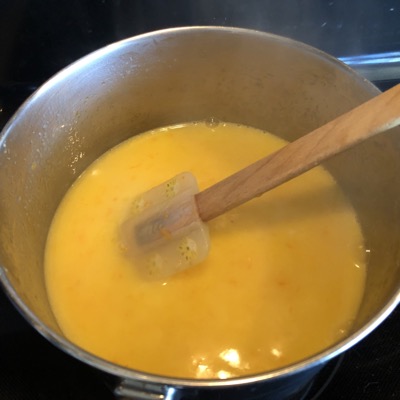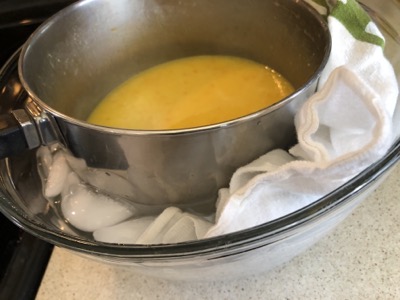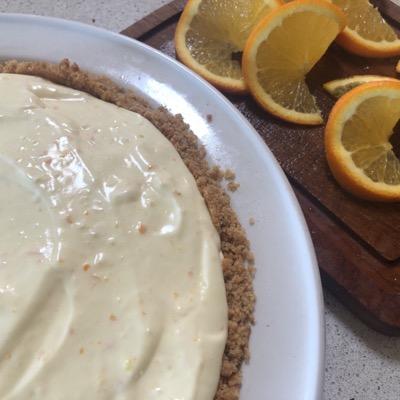
Recipe: This light dessert requires minimal stove time

Got oranges? Some of them can be juiced to flavor a bright, light pie for early spring. Kathy Morrison
One meaning of the word "windfall" refers to the orchard fruit that is knocked off the tree during a windy day or storm. That's exactly what I have received from my navel orange tree, thanks to the intense winds we've experienced recently: Oranges everywhere.
I don't need any more marmalade, and we are drinking up some of the windfall as orange juice, but I couldn't let the oranges just sit there without exploring more recipes.
Chiffon pie is a retro dessert, and there are many versions of it out there. I passed up the ones with Cool Whip and/or orange juice concentrate to land on this one, an adaptation of the lemon chiffon pie from Williams-Sonoma. It does use gelatin, which is not vegetarian, and egg yolks that are cooked into a custard. (If you're concerned about the eggs being cooked enough, see this W-S method of making eggs safe for cooking.)

Note: I made a simple graham cracker crust* for this, but use your favorite baked or no-bake single pie crust.
Sunny orange chiffon pie
Serves 8
Filling adapted from Williams-Sonoma.
Ingredients:
1/4 cup cold water
1 package (2-1/4 teaspoons) unflavored gelatin
3/4 cup granulated sugar
1/8 teaspoon salt
3/4 cup freshly squeezed orange juice, about 5 medium oranges
1 tablespoon fresh lemon juice
1 tablespoon or more finely grated orange zest (Note: Remember to zest the oranges before juicing)
4 egg yolks, lightly beaten
1-1/4 cups heavy cream
1/4 cup confectioners’ sugar
One 9-inch prepared pie crust, such as graham cracker crumb or shortbread cookie
Instructions:

In a large bowl place at least a dozen ice cubes and then add cold water to fill the bowl half-way. Set aside.
In a medium saucepan, pour the 1/4 cup cold water, then sprinkle the gelatin over it. Allow the mixture to soften for 5 to 10 minutes, then stir in the granulated sugar, salt, orange juice, lemon juice, orange zest and the egg yolks. Set the pan over medium heat and stir continuously, 6 to 8 minutes, until the mixture thickens and the gelatin dissolves. Important: Don't allow the mixture to boil.
Remove the pan from the heat and place it in the ice bath to chill. (If the pan floats and is in danger of tipping, anchor it in the bowl with a dish towel or two -- see photo.) Chill until the mixture is cold to the touch. It will thicken as it cools.
Whip the heavy cream with the confectioner's sugar in a large bowl until it forms soft mounds. Fold in the orange/gelatin mixture until thoroughly combined, then spread the filling into the prepared pie crust.
(Note: If the orange mixture has jelled too solidly to mix in easily with a spatula, loosen it first by whisking briskly. The combined mixture also can be blended together using the low speed of an electric mixer.)
Chill at least 3 hours, then remove from refrigerator about 15 minutes before serving. Garnish with orange slice twists and more whipped cream, if desired, and serve.

* Graham cracker crust: Pulverize or crush 1 sleeve (8 full-size) graham crackers into fine crumbs, or use 1-1/4 cups prepared crumbs. Stir in 3 tablespoons granulated sugar, 1 teaspoon of orange zest (optional) and 5 tablespoons melted butter. Press evenly into a 9-inch pie pan, and bake at 375 degrees for 5 to 7 minutes, until crust is firm. Allow to cool before filling.
Comments
0 comments have been posted.Sacramento Digs Gardening to your inbox.
Food in My Back Yard Series
May 6: Maintain soil moisture with mulch for garden success
April 29: What's (already) wrong with my tomato plants?
April 22: Should you stock up on fertilizer? (Yes!)
April 15: Grow culinary herbs in containers
April 8: When to plant summer vegetables
April 1: Don't be fooled by these garden myths
March 25: Fertilizer tips: How to 'feed' your vegetables for healthy growth
March 18: Time to give vegetable seedlings some more space
March 11: Ways to win the fight against weeds
March 4: Potatoes from the garden
Feb. 25: Plant a fruit tree now -- for later
Feb. 18: How to squeeze more food into less space
Feb. 11: When to plant? Consider staggering your transplants
Feb. 4: Starting in seed starting
Sites We Like
Garden Checklist for week of May 11
Make the most of the lower temperatures early in the week. We’ll be back in the 80s by Thursday.
* Plant, plant, plant! It’s prime planting season in the Sacramento area. Time to set out those tomato transplants along with peppers and eggplants. Pinch off any flowers on new transplants to make them concentrate on establishing roots instead of setting premature fruit.
* Direct-seed melons, cucumbers, summer squash, corn, radishes, pumpkins and annual herbs such as basil.
* Harvest cabbage, lettuce, peas and green onions.
* In the flower garden, direct-seed sunflowers, cosmos, salvia, zinnias, marigolds, celosia and asters. (You also can transplant seedlings for many of the same flowers.)
* Plant dahlia tubers.
* Transplant petunias, marigolds and perennial flowers such as astilbe, columbine, coneflowers, coreopsis, dahlias, rudbeckia and verbena.
* Keep an eye out for slugs, snails, earwigs and aphids that want to dine on tender new growth.
* Feed summer bloomers with a balanced fertilizer.
* For continued bloom, cut off spent flowers on roses as well as other flowering plants.
* Add mulch to the garden to maintain moisture. Mulch also cuts down on weeds. But don’t let it mound around the stems or trunks of trees or shrubs. Leave about a 6-inch-to-1-foot circle to avoid crown rot or other problems.
* Remember to weed! Pull those nasties before they set seed.
* Water early in the day and keep seedlings evenly moist.